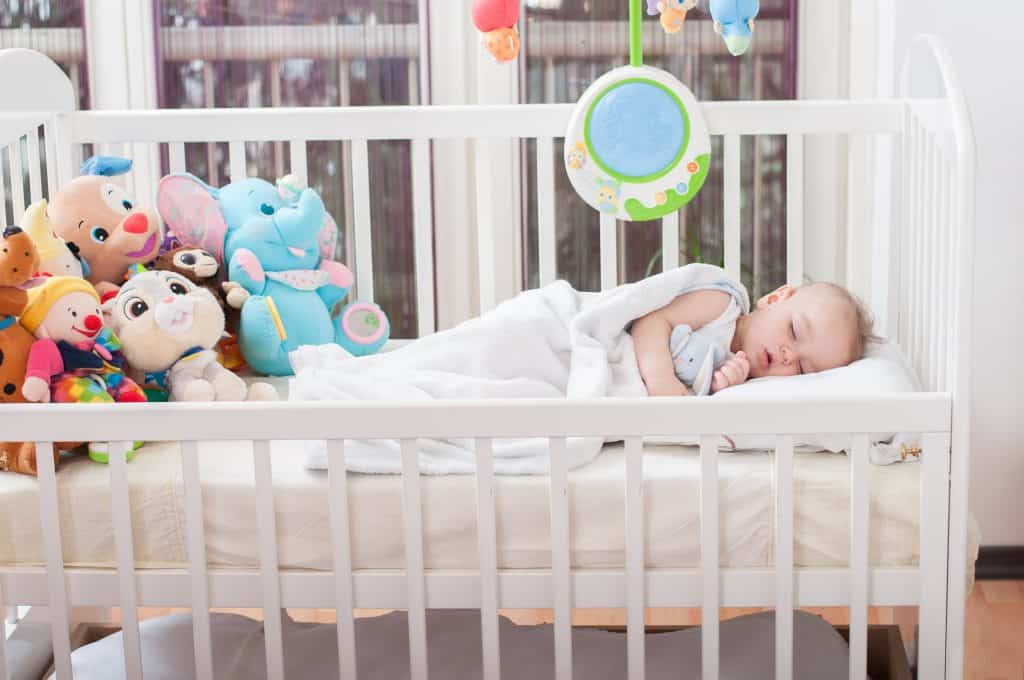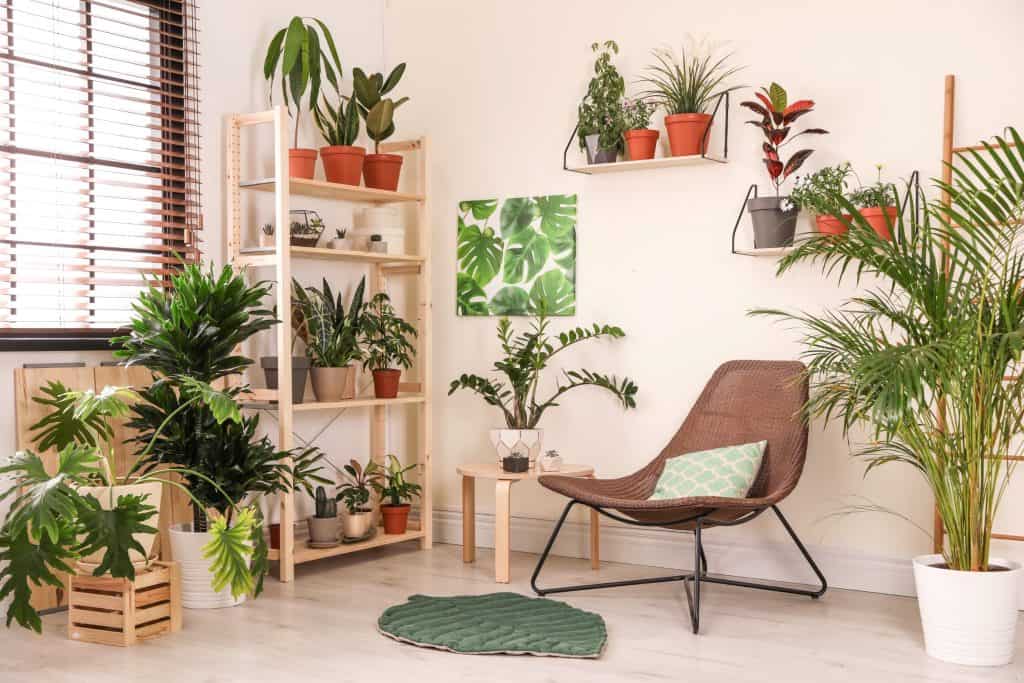Babies are extremely vulnerable to things most adults would brush off – even humidity levels pose a potential health risk for them! Everything needs to be managed perfectly to make sure your baby ends up strong and healthy.
Fortunately, getting their room’s humidity levels “just right” is actually quite doable.
Try to keep your baby’s room humidity levels between 40%-50%. Focus on improving circulation to reduce humidity imbalances. Look for combo units that can deal with both high and low humidity conditions you’ll encounter across the seasons.
You may also want to look into placing plants in the room – they do a great job improving humidity regulation for very little upkeep.
Humidity is an urgent consideration for your child’s health. Most areas in the USA deal with problems from both humidity level extremes, so prepare your household accordingly.
Why Does Baby Room Humidity Even Matter?

Humidity drastically affects the impact of temperature in a room. This is a pressing issue, as babies have poor thermoregulation – liable to overheat or overcool drastically faster than adults.
High humidity drastically bolsters the effect of warmer environments, which could easily lead to overheating even if the temperature range should ostensibly be tolerable for your baby. Conversely, low humidity conditions can make colder environments seem unbearably chilly.
Humidity by itself also directly affects your baby’s living conditions. If humidity is too low, the dry air could irritate their respiratory system and skin. If the humidity is too high, bacteria cultures and viruses can develop in their environment – which your poor infant isn’t equipped to handle.
Ideal Baby’s Room Humidity Levels
Ideal baby’s room humidity levels should fall between 30% to 50%, but people usually prefer slightly higher ranges of 40% to 60% humidity. We’d recommend compromising in the range of 40%-50%, as going beyond that risks potential mold and bacteria growth in the room.
Improve the Room’s Ventilation
If something feels off or unpleasant in your baby’s room, trust your gut. It’s better to be safe than sorry with your kid’s health on the line. Poor ventilation is a problem for both high and low humidity environments, often leading to unequal distribution of humidity.
Preliminary Measures

Open a window. A change as small as this would work wonders at improving the area’s airflow, reducing humidity and general stuffiness in a matter of moments. Even low-humidity environments benefit from improved circulation, so be sure to do this when the air feels stale.
You could also bring an electric fan into your child’s room to fill the same purpose. If you choose to do this, bear in mind that you should never point the fan directly at them. Circulating air could dry out your child’s nose and mouth, making them sick with prolonged contact.
Instead, point it on the wall opposite your child’s area. This ensures the circulated air still cools the room without subjecting your baby to the risks of direct exposure.
Use A Humidifier-Dehumidifier Combo
The change in season can be drastic for some states, leading to humidity problems from both extremes. This would require the services of humidifiers and dehumidifiers at different points in time, which might make for a hefty investment to splurge on.
Fortunately, some dual-purpose units can fill both functions available on the market. A single humidifier-dehumidifier combo is probably going to be cheaper (and certainly more manageable to maintain!) than both of those units would have been on their own.
Selection Criteria
At the barest of minimums, go for a unit with an internal humidistat. Humidistats check for the concentration of humidity in the air, giving you an idea of when you need to keep the machine running. Some combo units also shut off automatically when humidity levels are ideal.
Some combo units can even adjust their function to meet desired parameters, allowing the unit to maintain ideal humidity levels independently – requiring only token supervision.
It’s still important to know how to use the unit manually, so steer clear of fancy units boasting features you don’t have plans to make use of. You want a practical unit with intuitive controls to meet your baby’s needs. Needless complexity just means more ways for mistakes to develop.
Lastly, go for a quieter unit. Some combo devices can be rather loud, which would hamper your baby’s rest. Be sure to test the machines before buying them. If you’re purchasing them online, watch instructional videos of your planned purchase to give you a better idea of what to expect.
Put Plants in Your Baby’s Room

Plants are a great addition to any household dealing with this issue, regulating humidity from both concentration extremes on top of providing an abundance of clean air to boot!
Some plants are also ridiculously hardy! They can survive even in difficult conditions, allowing amateur gardeners a wide margin of error. A select few – such as English Ivy – are so tough that they can even handle borderline-neglectful conditions.
Some species of plants are better equipped to deal with certain humidity conditions than others. Be sure to pick the right specimens for the job!
Humidifying Plants
Plants can humidify their surroundings via evapotranspiration. This happens when water gathered by the roots of the plant reaches the leaves, evaporating off the plant leaves’ stomata. This process has a cooling effect on their surroundings and can happen during the day and at night.
Think of it as a spray bottle, with the roots being the intake and the leaves being the nozzle.
The process naturally works best among specimens with plenty of surface area on their leaves to facilitate effective evaporation. We’d recommend trying out English Ivy here, as the plant is durable, cheap, and easy to procure.
Dehumidifying Plants
If you want to dehumidify a room, stick with plants more suited for arid or tropical environments. What plant species do you think would be stingy with their water?
A general rule of thumb here is seeking out plants with very little surface area or otherwise have features that minimize water loss from evaporation. Plants with small, waxy leaves are a great choice. You could also start with, say, cacti – they’ll help keep moisture buildup in check.
Clarifications
When it comes to plants, the same process governs both their humidifying and dehumidifying capabilities: evapotranspiration. The difference comes with how efficient they are at each step.
They’re both effectively spray bottles in function with different levels of effectiveness.
Plants in areas with plentiful water have a wider “nozzle”, allowing them to release excess water rapidly and in greater quantities. Their primary intake comes from the roots, so be sure to water them consistently – let the stomata on their wide leaves evaporate water to cool their environment.
Plants in areas with scarce water have a smaller “intake”, allowing them to siphon and contain excess moisture. You won’t need to water them as they’ll take all the moisture they need from their surroundings, reducing excess humidity in the air. They’ll do so with minimal maintenance.
Figure out what your baby’s room needs most, then find the right type of plants to fit the role. Just be sure to check if anyone in the family has any inconvenient allergies first!
Final Thoughts
Baby’s room humidity is an important consideration for your baby’s health. Relative humidity changes drastically between seasons, so it’s better to equip yourself to handle both high humidity and low humidity conditions. Try to do so as efficiently as possible to save on time, expenses, and effort.

